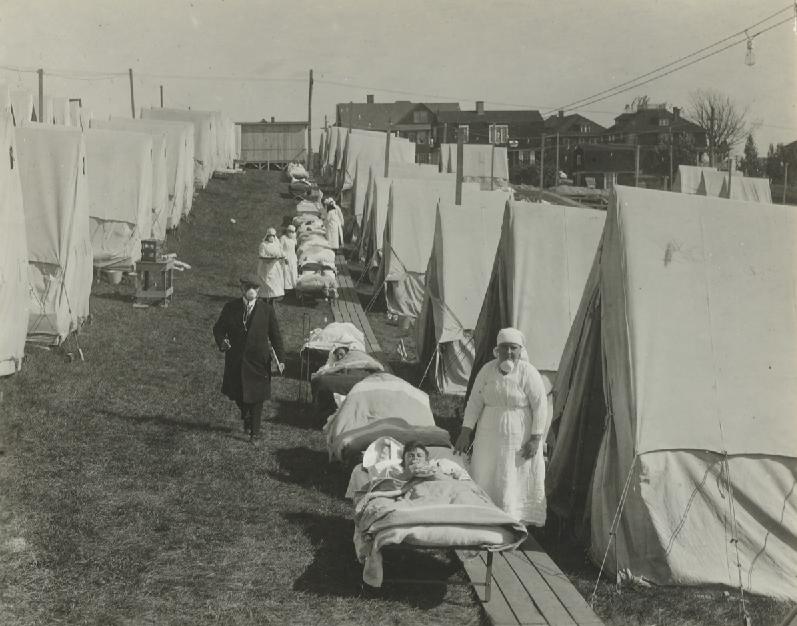[The worst pandemic of the century killed more than half a million Americans and some 20 million people worldwide]
With all the hoopla about COVID-19 being a hoax even after so many thousands of people have died from the virus, I’d like to share this story written by Michigan historian and author, Larry B. Massie. It was in 1918 – 102 years ago – that millions of lives were lost. Just as it was then, so it still is today, there is no known nor proven vaccine. The best we can do right now is cooperate as best we can with the directives given by our civic leaders, using common sense to weather this season of widespread disease. It’s not about constitutional rights, but rather, making humane decisions to help stem the tide.
Authorized for reprint: The Influenza Pandemic of 1918 by Larry B. Massie:
[At first it was a joke – a funny sounding foreign word. Vaudeville comedians across the country quipped:
I had a little bird named Enza
I opened the window and in-flu-enza!
That was in the late summer of 1918. Then in September, influenza leaped across the ocean from the western front to the Atlantic seaboard, and the newspaper headlines began marking the death toll. The laughter stopped.
Transmitted in March 1918 to Europe from China, where it had raged since 1910, the viral disease raced through the armies embroiled in World War 1. The Germans called it Blitzkatarrh. The Allied forces named it the Spanish influenza because of a particularly virulent outbreak in Spain.
Its symptoms included fever and chills, sinus infections, pneumonia and encephalitis. Three distinct types emerged: (1) a very severe form with phenomenally rapid development and a fatal end within 36 to 48 hours; (2) a moderately severe onset with lung complications of a mild type, generally followed by easy recovery; (3) a mild beginning and quick improvement followed, however, after a few days, by a sudden rise in temperature and very serious results. The disease proved particularly fatal to pregnant women, children under two years old and, strangely, those between 20 and 40 years of age, who were slaughtered by the millions.
In America it hit like a biological bombshell. By the end of 1918 at least 46 states were affected and ultimately one out of every four citizens feel ill. During mid-October, New York City reported 4000 new cases and 250 deaths each day.
RELATED: Heartbreaking: Georgia Teen (Justin Hunter) Loses Both Parents to COVID-19 Within Days

Particularly hard-hit were army training camps. The death toll among U.S. armed forces surpassed 50,000, more than were killed in battle during the entire World War 1.
The plague reached Michigan at the end of September. On October 1st, 13 cases from southern Michigan had been reported to the Michigan Department of Health. The following day, 121 cases were reported, 90 of them from Jackson County. During the next three weeks, Jackson County continued to report more cases than any other Michigan county. Within that time, however, the disease struck practically every county in both peninsulas.
People began wearing face masks in public places. Authorities in Lansing advised against licking postage stamps and envelope flaps because of the dangers of infections. With no vaccine available, the U.S. Surgeon General issued a circular which, among other suggestions, advised people to breathe through their nose instead of their mouth.
The number of cases and the death toll continued to soar. By October 18th nearly 2,000 new cases were being reported daily. On that date, Dr. R.M. Olin, commissioner of the Michigan Department of Health, issued an order closing churches, dance halls, pool rooms and all places of amusement and prohibiting public funerals or public gatherings of any kind.
The ban, in conjunction with mounting numbers of sick athletes and coaches, brought the cancellation of collegiate football schedules across the nation, including Western State Normal School (now Western Michigan University), Kalamazoo College, the University of Michigan and Notre Dame. As a result, the NCAA ruled the 1918 season not a factor in eligibility. Some players, such as Laurium, Michigan native George Gipp, immortalized by Ronald Reagan in the classic film, “Knute Rockne – All American,” were allowed to play five seasons on the college gridiron, instead of four.
Despite Michigan’s ban, the toll continued to climb, reaching its peak on October 23rd when more than 4,200 new cases were reported across the peninsulas. Finally, the number of cases began to drop, and on November 7th the state lifted the ban on public gatherings.
In the meantime, Michigan’s hospitals struggled to keep up with the patient load that clogged every room including hallways. The lack of available beds brought on by the epidemic motivated Detroit’s Harper Hospital to change from an open to a closed Hospital, thereby no longer admitting patients of doctors not on its staff. Butterworth Hospital in Grand Rapids overflowed with influenza cases, and even the student nurses found themselves working seven days a week, giving tepid sponge baths to patients and repeatedly changing perspiration-soaked bedding.
Borgess Hospital, which had dedicated its new facility on Gull Road the year before, faced its greatest crisis since it opened as Kalamazoo’s first hospital in 1889. The epidemic struck the nearby Nazareth community in early October. Thirty sisters fell ill as did scores of students at the two schools there.
The epidemic raced through the Student Army Training Corps candidates at Western State Normal School who had been crowded into a hastily-erected drafty barracks at the foot of Oakland Avenue. The Sisters of St. Joseph promptly placed the new hospital at the disposal of health officials who allocated an entire floor to the Western student sufferers. Every available sister in Kalamazoo reported for duty at the hospital.
With Bronson Hospital also overflowing with influenza victims, on October 17th, the city health board opened an emergency hospital in the West South Street mansion of Althea Everard. During the following month, 79 patients were treated there.
Battle Creek faced a similar situation. In mid-October, the city leased the Richard Kingman dwelling on East Main Street to accommodate the overflow of patients from Nichols Hospital.
Particularly hard-hit was nearby Camp Custer, which had opened as a training cantonment for drafted army troops the previous year. Poorly housed in crowded quarters, soldiers at Camp Custer began dropping like flies. The camp surgeon ordered each soldiers’ bunk draped with mosquito netting and personnel to sleep in alternate positions of head to toe so as not to breathe on each other. Each trainee had his throat sprayed twice a day. Those primitive precautions brought little relief; 10,000 men at the camp contracted the disease – 663 died in October alone. By the year’s end 841 soldiers had succumbed.
Many decades later, the children of Ernest L. Ferris, a Kalamazoo drayman, told stories of how their father was hired to cart corpses from the camp – at night so the public did not panic at the extent of the calamity.
As the year wore on the epidemic continued to rage across Michigan and the nation. December 31, 1918, saw nearly 2,000 new cases reported. Gradually, during the winter of 1919, the fury of the disease abated, although a less severe outbreak occurred the following winter. Michigan’s final tally for the months of October, November and December 1918 documented 116,302 cases of influenza reported with 6,336 deaths. Another three to four thousand died from pneumonia as a secondary infection brought on by the influenza.
Rare was the American family unaffected by the viral holocaust. The worst pandemic of the century killed more than half a million Americans and some 20 million people worldwide.]
Side Note: Larry’s wife, Priscilla Hagerman Massie’s family was directly affected by the Influenza Pandemic of 1918. Her Grandmother, Jewel Macarty Hagerman grew up in a large Irish family in Calumet, Michigan. When the 1918 Pandemic came to the Upper Peninsula of Michigan it wiped out all six of her brothers and sisters, along with her parents. Jewel, was of course devastated, just 18 years old and decided to start a new life in Flint, Michigan.
Email Larry Massie at: [email protected]; Larry Buford at: [email protected]
We Publish News 24/7. Don’t Miss A Story. Click HERE to SUBSCRIBE to Our Newsletter Now!





